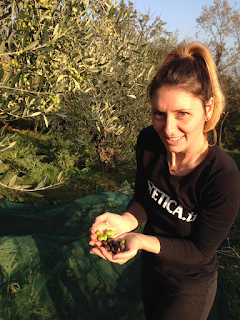Vi siete mai chiesti come si fa a ricavare dalle olive il magnifico, cosidetto "oro verde"? Quel prodotto di tradizione agroalimentare mediterranea e di fama mondiale? Prima di spiegare il processo passo per passo, vale la pena soffermarsi sull'aspetto storico che a me piace sempre esplorare per capire le origini dei miei interessi.
Eccelenza mondiale nella qualità dell'olio di oliva è legata al bacino Mediterraneo: dalla Spagna, Italia, Grecia e Portogallo in Europa, al Marocco e Tunisia nel Nord Africa, e infine Turchia e Siria nel Medio Oriente. L'Unione Europea nel suo complesso occupa l'80% della produzione mondiale dell'olio di oliva. Le quote minoritaire vengono prodotte nel continente americano, Australia e Giappone. Abbiamo imparato dunque che, dopo la Spagna, l'Italia è il secondo produttore dell'olio d'oliva in Europa e nel mondo. Hurraaaaaa al buon olio in casa!
Certamente ve ne siete accorti che se ne fa un largo uso anche nell'industria cosmetica: inizialmente per il sapone d'oliva e in seguito le maschere per i capelli, creme per il viso e corpo eccetera. Ma lo sapevate che un tempo si usava come combustibile per le lampade a olio?! Aiuto, che spreco!🙈
Olio d'oliva, sopratutto quello extravergine, è anche tra i prodotti alimentari più soggetti a adulterazione e contraffazione, proprio a causa dell'alto valore commericiale. Tanto che l'ufficio antifrode dell'UE ha una vera e propria task force per il controllo e la tutela dell'olio di oliva.
Non nuoce conoscere anche gli effetti sulla salute, i benefici sul corpo, oltre a quelli sul palato deliziato: antiossidante, antiinfiammatorio e antibatterico. Da non dimenticare effetto benefico nella prevenzione di malattie cardiovascolari.
Veniamo dunque al dunque, sporchiamoci le mani! In realtà è altamente consigliabile utilizzare i guanti di protezione durante la raccolta, specialmente se si fa a mano. La raccolta in Italia avviene da metà ottobre a dicembre.
Step 1 - stesura dei teli o lenzuoli o reti intorno all'albero
Step 2 - raccolta delle olive con vari metodi: a mano, con una forca (a mo' di pettine) oppure con l'abbacchiatore meccanico (scrullatore) per raggiungere i rami più alti in minore tempo e fatica
Step 3 - raccolta delle reti e versamento in casse, stando attenti alla pulizia manuale delle foglie
Step 4 - si ripetono i primi 3 passi fino all'esaurimento degli alberi a disposizione
Step 5 - portare le olive al frantoio e il nostro lavoro manuale è finito qui.
Ci sono due tipi di oleificio. Il frantoio tradizionale utilizza la forza della gravità come motore della movimentazione del prodotto nel corso della lavorazione. Oggi è più diffuso l'impianto di movimentazione meccanica e idraulica a ciclo continuo. Io vi parlerò della mia esperienza personale con quest'ultimo.
Le olive vengono versate su un livello interrato che dosa la quantita in manciate, in modo che il processo succcessivo avvenga fatto bene. Si tratta della pulizia meccanica delle foglie mediante un soffiatoio (una specie di fon per le olive) e lavaggio delle stesse con l'acqua. Così pronte vengono di nuovo raccolte e, attraversato il processo di frantumazione, vengono raccolte in una specie di calderone ampio dove avviene la mescolatura meccanica. Questa parte del processo è la più lunga e importante. Quando il patè raggiunge una densità giusta, viene mandato al prossimo passaggio che è l'estrazione dell'olio tramite la pressa con il filtro. Ci sarà uno scarto, ma nel contenitore esterno che eroga il prodotto finale, esce fuori prioprio l'oro verde, pronto per essere consumato. Conviene portarsi dietro un contenitore per l'olio, ma nel caso ci sono delle latte vuote direttamente negli oleifici, disponibili per il consumatore.
Certamente quando hai seguito il processo dall'inizio alla fine e vedi il dolce frutto del tuo lavoro, il risultato diventa ancora più significante ed apprezzato. Ringrazio il Consorzio Terra di San Marino per avermi concesso di documentare ogni passaggio con tanto di foto e video.
Per chiudere con un cenno storico, le prime produzioni dell'olio di oliva -rigorosamente extravergine- e le tecniche di conservazione, sono stati sviluppati dagli antichi greci e romani. Tecniche rimaste immutate per secoli. Ecco a voi l'elisir dell'eterna giovinezza!
























